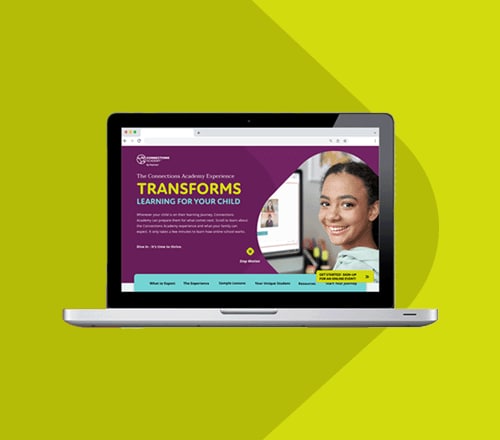Student Stories: District C
byCharlotte Davies
6 min to read
Connections Academy has a long history of providing students with the tools they need to thrive through practical hands-on experience. Students need to be prepared for their futures.
As the nature of work evolves with emerging technologies like AI and other digital tools, the role humans play in the workplace is also changing. High school students need to be prepared for this new way of working, which, perhaps counterintuitively, appears to have a decidedly more human feel to it.
Enter District C's initiative, Teamship.
What Is District C and Teamship?
Teamship is a new way of thinking about internships from District C, resting on the idea that developing human-to-human skills like collaboration, adaptability, and problem-solving is a more impactful way to prepare students for the future of work. When Arkansas Connections Academy decided to partner with District C in 2024, a pilot program began to take shape.
A statement on District C’s homepage sums up their ethos and their innovative Teamship initiative pretty simply:
“Work is changing. Automation is impacting jobs across all industries. Employers are looking for a new kind of talent prepared for the uniquely human job description of the modern economy: work in diverse teams to solve complex problems. Today’s work requires a different kind of preparation.”
District C Pilot Program at Arkansas Connections Academy
As part of the District C Pilot Program at Arkansas Connections Academy, a group of 10th and 12th grade students were paired with real businesses and briefed on some of their pain points. Students then had the chance to come up with detailed action plans to solve them. In turn, the businesses gave students feedback on the solutions they had put together as well as how they intended to build off what the students had provided.
“I think my first reaction was, ‘what a great opportunity’,” said Erin Lieblong, principal at Arkansas Connections Academy. “We did not want to limit it to students who were only in high academic achievement pathways.”
Lieblong explained how her school wanted to make this opportunity as available as possible to any student who was engaged in learning, above all else.
“We wanted to make sure students who were going to plan to go to the workforce or who were going to go to a trade school or who might not know what they want to do yet,” she continued, “we wanted to give this opportunity to any student.”
Students could apply directly, but teachers could also recommend students they felt would benefit from the program. Once all applications were in and students were selected, students were contacted and given the opportunity to enroll in the program.
Student Outcomes and the Impact of Teamship and District C
While initially there was some uncertainty about what to expect, “students that ended up participating had great outcomes and they grew in a lot of areas,” said Lieblong. “We know that when students get to contribute to society, and they get to grow in communication and they get to showcase a depth of understanding,” she said, “we know that they're going to have personal growth.”
Lieblong saw how the program could add value to the students’ lives and their growth as individuals, beyond what skills they could gain for their careers.
Networking, Collaboration, and Engagement
One of the core goals of the District C partnership was building human-based skills for the workplace, so naturally “the networking piece and the collaboration piece was large,” said Lieblong, “I don't know that students really understood how much they would grow together and the engagement piece would be substantial.”
Soft skills like communication, collaboration, and problem-solving became essential as the students worked together. “You don't always know how important and how relevant it is just to be able to communicate with a peer,” said Lieblong. “Students not only got to build friendships and build rapport with other students from other schools across the nation, but they also got to understand just the basic level of collaboration can really impact their career, and it can impact how to just move day to day through life, knowing how to communicate with people.”
Developing Meaningful Friendships and Connections
An intentional element of the Teamship initiative was the connections students made with each other. While one of the specific goals of the program was professional networking, Lieblong pointed out that the program gave students the chance to build personal friendships and shared a story about a student from Georgia who became close enough with a student from Arkansas to attend their high school graduation.
“For families who are concerned about the level of socialization and engaging with other [virtual] students,” she said, “I would tell them that we are always looking for opportunities to enhance communication efforts. And the more we can increase those opportunities, the more value we're going to see from those.”
Learning from Mistakes and Building a Growth Mindset
Lieblong said she didn’t receive any feedback that she felt built herself as a professional until she reached adulthood. The students who participated in District C, however, had the advantage of receiving feedback as part of the structure of the program, and learned to understand and expect feedback.
“I think sometimes we forget how valuable it is to have a growth mindset,” said Lieblong. “I know I can make a mistake, but I know I can try harder the next time and embrace challenges, and I can see failures as opportunities." Having this kind of attitude helps develop resilience and makes people more likely to remain motivated to achieve their goals.
Gaining Optimism for the Future
As an educator, Lieblong knows the impact that this kind of experience can have on students firsthand, especially as they prepare for life after high school and might struggle to feel optimistic about the future. Getting an interactive experience with employers and gaining valuable feedback gave the students confidence, she said, and perhaps most crucially, “It made them understand the equity and the accessibility to these opportunities was not limited. You're going to get opportunities in your future that will allow you to participate and grow as a person.”
Heading into the Future
Lieblong believes the students at Arkansas Connections Academy who participated in the Teamship program will find a lot of success not only because they’ve done something that can be the foundation for their future resumes by working with top tier companies, but also because they have developed practical and interpersonal skills that they can bring with them to jobs across a variety of industries.
Another big benefit? Interview skills.
“Sometimes we all know as adults, interviewing can be the scariest part of getting a job,” said Lieblong. “They have already engaged in opportunities to be interviewed and to participate in interviews and, again, to give feedback and to receive feedback. And so the confidence they've gained from that is going to set them apart at the very beginning.”
Build Career Skills Online
Explore the Career Readiness offerings at Connections Academy to learn how we’re preparing students for their future, including strategic industry partnerships and career pathways in business, healthcare, and information technology.



